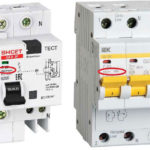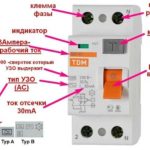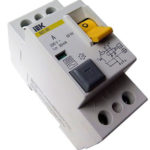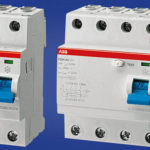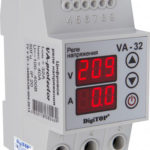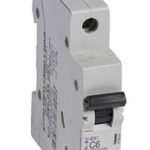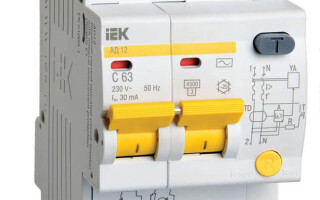The differential machine is a unique device that combines the functions of two protective devices at once in a single housing - this is at the same time RCD and circuit breaker. Professionals recommend using differential circuit breakers without fail when installing or reconstructing wiring.

What is the purpose of differential automata, by what parameters is it selected and what is its connection scheme - we will try to give answers to these questions below.
Content
What are differential machines for?
The direct purpose of the differential machine is to protect a person from electric shock through direct contact. The device simultaneously monitors both the occurrence short circuit, and the manifestation of signs of leakage of electricity through damaged conductive components of the network.
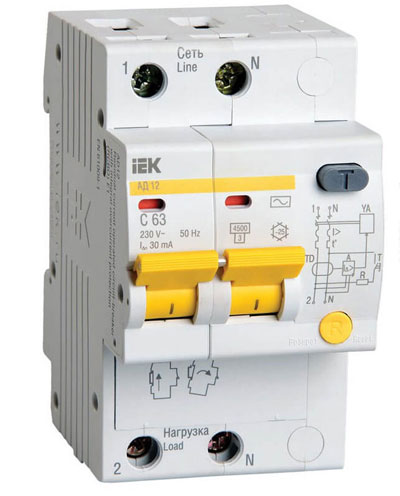
The differential machine will de-energize the monitored line when:
- short circuit;
- overheating of electrical wiring due to exceeding the setting of the rated current of the difavtomat;
- earth leakage is greater than the corresponding setting.
So, a simple device is quite capable of securing an apartment or a private house, preventing the occurrence of emergencies caused by problems with electricity.
The advantage of using a differential automaton is that there is no need RCD selection, because it is already contained in the components of the differential automaton. One device that combines the functions of two (RCD and circuit breaker), takes up less space in the electrical panel by the size of a single-pole machine - its width is 17.5 mm.
Among the shortcomings, one can single out the probability of failure of one of the two components of the difavtomat - replacing a separate part is impossible, which will force you to purchase a new differential automaton.
Technical device
Structurally, difautomats are made of a dielectric material. The back has a special mount for installation on DIN rail. Inside, they consist of a two-pole or four-pole switch and a differential protection module connected in series with it. This module is a differential current transformer through which zero and phase pass, thereby forming the primary winding and the control winding - the secondary winding.
How does a differential machine work?
The principle of operation of the difavtomat is based on the use of a special transformer, the operation of which is based on changes in the differential current in the conductors of electricity.
When leakage currents appear, the balance is disturbed, since part of the current is not returned.The phase and neutral wires begin to induce different magnetic fluxes and a differential magnetic flux occurs in the core of the current transformer. As a result, a current appears in the control windings and the release is activated.
In case of overheating in the circuit breaker module, a bimetallic plate is activated and opens the circuit breaker.
main parameters
Any differential machine has 8 terminals for a three-phase network and 4 for a single-phase network. The device itself is modular and consists of:
- Housing made of non-combustible refractory material;
- Terminals with marking intended for connection of conductors;
- Lever on-off. The quantity depends on the specific device model;
- Test buttons that allow you to manually check the performance of the differential machine;
- A signal light informing about the selected type of operation (leakage or overload).
When choosing a differential machine, all the information of interest can be found directly on the body of the device itself.
The choice of difavtomat must be made based on many parameters:
- Rated current - shows what load the difavtomat is designed for. These values are standardized and can take the following values: 6, 10, 16, 20, 25, 32, 40, 50, 63A.
- Time-current characteristic - the values \u200b\u200bcan be equal to B, C and D. For a simple network with low-power equipment (rarely used), type B is suitable, in a city apartment - C, at powerful manufacturing enterprises - D. For example, when starting the engine, the current increases sharply for a fraction of a second, after all, some effort is needed to promote it.This starting current can be several times the rated current. After starting, the consumed current becomes several times less. This is what this setting is for. Characteristic B means a short-term excess of such a starting current by 3-5 times, C - 5-10 times, D - 10-20 times.
- Differential leakage current – 10 or 30 mA. The first type is suitable for a line with 1-2 consumers, the second - with several.
- Differential protection class - determines which leaks the difavtomat will react to. When choosing a device for an apartment, AC or A classes are suitable.
- Breaking capacity - the value depends on the rating of the machine and must be higher than 3 kA for machines up to 25 A, 6 kA for circuit breakers for current up to 63 A and 10 kA for circuit breakers for current up to 125 A.
- Current limiting class - shows how quickly the line will be disconnected when critical currents occur. There are 3 classes of difavtomatov from the "slowest" - 1 to the most "fast" - 3 in response, respectively. The higher the class, the higher the price.
- Terms of Use - Determined based on needs.
Choosing a difavtomat by power
In order to select a difavtomat by power, it is necessary to take into account the condition of the wiring. Provided that the wiring is of high quality, reliable and meets all the requirements, the following formula can be applied to calculate the nominal value - I=P/U, where P is the total power of electrical appliances used on the line of the differential machine. We choose the difavtomat closest at face value. Below is a table of the dependence of the difavtomat rating on the load power for a 220 V network.
Attention! Electrical wires must be correctly selected based on the load power.
All characteristics of difavtomatov are indicated directly on the body of the device, which will facilitate the selection of a suitable differential automaton and help determine which difavtomat is best suited for an apartment.
| Power | Cable | Differential machine |
|---|---|---|
| up to 2 kW | VVGngLS 3x1.5 | C10 |
| 2 to 3 kW | VVGngLS 3x2.5 | C16 |
| from 3 to 5 kW | VVGngLS 3x4 | C25 |
| from 5 to 6.3 kW | VVGngLS 3x6 | C32 |
| from 6.3 to 7.8 kW | VVGngLS 3x6 | C40 |
| from 7.8 to 10 kW | VVGngLS 3x10 | C50 |
At the moment, difavtomatov with two types of release are on sale:
- Electronic - has an electronic circuit with a signal amplifier, which is powered by the connected phase, which makes the device vulnerable in the absence of power. If zero is missing, this will not work.
- Electromechanical - does not require external power sources for operation, which makes it self-contained.
Connection
Connecting a difavtomat is a very simple process. The upper part of the differential machine contains contact plates and clamping screws designed to connect zero N and phase L from the meter. The lower part has contacts to which the line with consumers is connected.
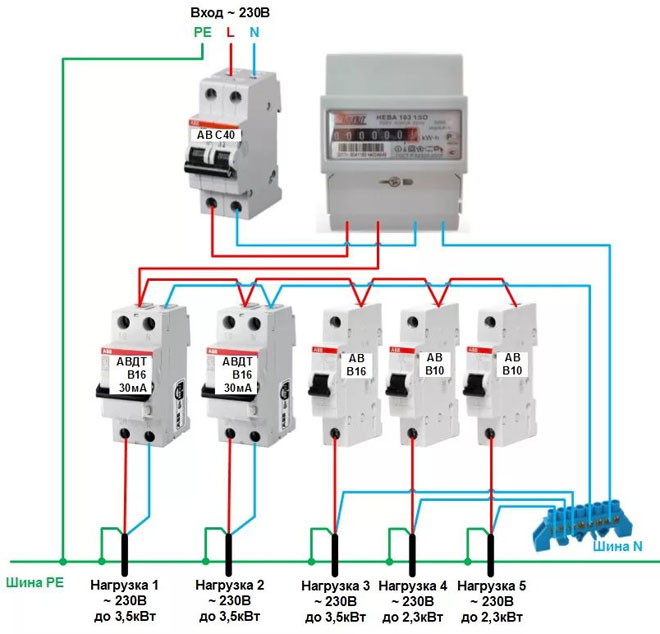
The connection of a difavtomat can be represented as follows:
- Stripping the ends of the conductors from the insulating material by about 1 centimeter.
- Loosen the clamping screw a few turns.
- Conductor connection.
- Screw tightening.
- Checking the quality of fastening by the simplest physical effort.
Choice between configuration RCD + an automatic machine and a conventional difavtomat should be determined by the availability of space in the shield and the price of the devices themselves.In the first option, the complexity of installation will slightly increase.
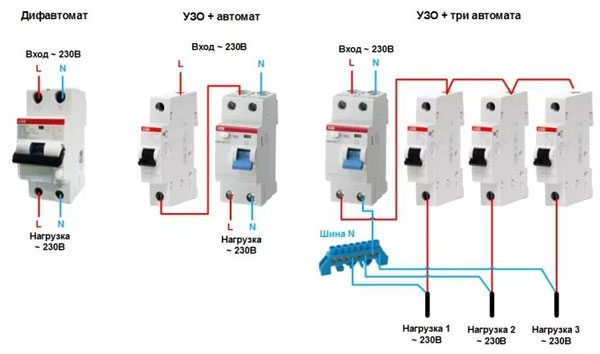
In the case of a single-phase 220 V network used in most apartments and houses, a two-pole device must be used. Installation of a differential machine in this case can be carried out in two ways:
- At the entrance after the electric meter for all apartment wiring. When using this scheme, the supply wires are connected to the upper terminals. The lower ones are loaded from various electrical groups separated by automatic switches. A significant disadvantage of this option is the difficulty in finding the cause of failure in the event of an automation operation and the complete shutdown of all groups in case of malfunctions.
- For each group of consumers separately. This method is used for protection in rooms where there is an increased level of air humidity - bathrooms, kitchens. The method is also relevant for places where electrical safety should be at the highest level - for example, for a nursery. You will need several differential automata - despite the high costs, this method is the most reliable and guarantees uninterrupted power supply, and the operation of any of the differential automata will not make the others work.
In the presence of a three-phase network of 380 V, a four-pole difavtomat must be used. The option is used in new houses or cottages, where the device needs to withstand high loads from electrical appliances. It is also possible to use such a connection of difavtomatov in garages due to the possible use of powerful electrical equipment.
It can be concluded that the connection scheme of differential automata is not much different from similar circuits for RCD. At the output of the device, the phase and zero from the protected section of the network must be connected. The security of this particular group will be monitored.
Differential automata are successfully used in both single-phase and three-phase AC networks. The installation of such a device significantly increases the level of safety in the operation of electrical appliances. In addition, the differential circuit breaker can contribute to the prevention of fire associated with the ignition of insulating material.
Similar articles:
